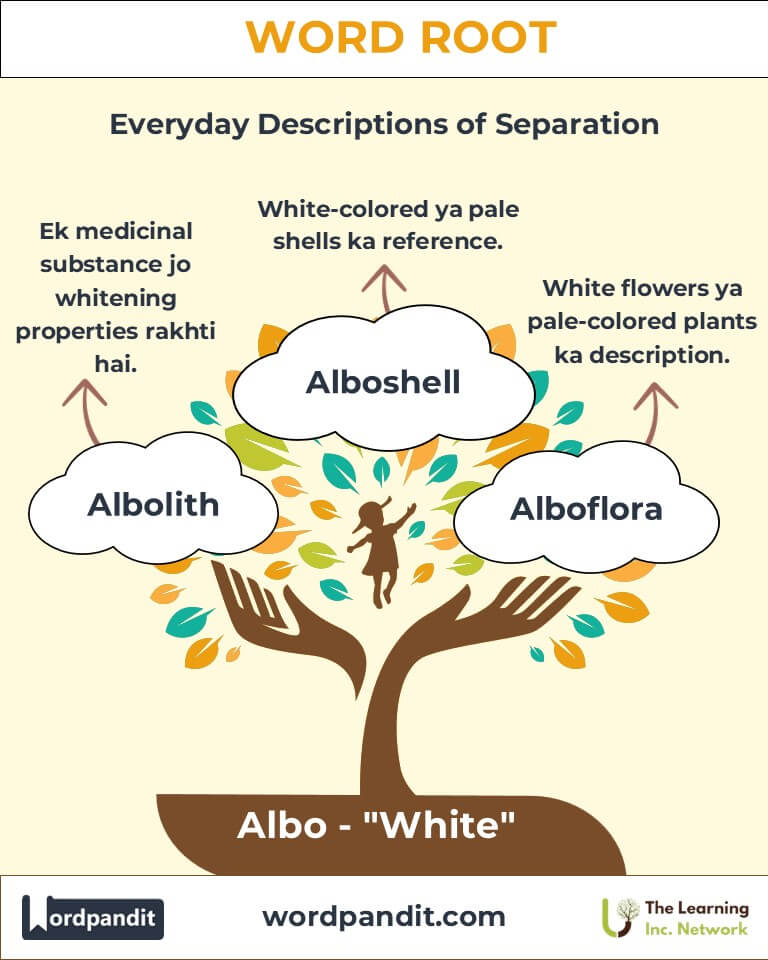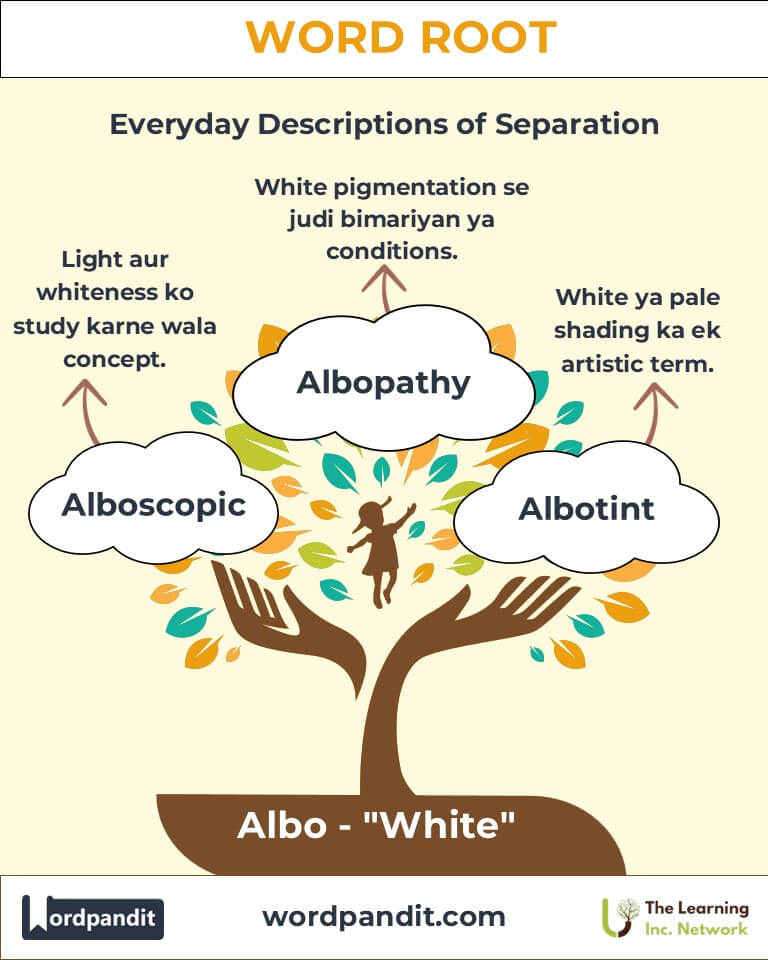Albo: The Root of Whiteness Across Language and Science
Discover the elegance and depth of the word root "albo," derived from Latin and signifying "white." From common terms like "albino" to specialized words like "albugineous," this root has illuminated language and science, connecting ideas of purity, brightness, and clarity.

Table of Contents
- Introduction: The Essence of Albo
- Etymology and Historical Journey
- Mnemonic: Unlocking the Power of Albo
- Common Albo-Related Terms
- Albo Through Time
- Albo in Specialized Fields
- Illustrative Story: Albo in Action
- Cultural Significance of the Albo Root
- The Albo Family Tree
- FAQs about the Albo Word Root
- Test Your Knowledge: Albo Word Root Quiz
- Conclusion: The Enduring Legacy of Albo
1. Introduction: The Essence of Albo
Picture a serene winter landscape, its whiteness symbolizing clarity and tranquility. The root "albo," pronounced al-boh, stems from Latin and means "white." Whether in descriptive terms like "albino" or specialized fields like anatomy, "albo" evokes ideas of purity, brilliance, and visibility. This root has shaped our understanding of color, perception, and expression.

2. Etymology and Historical Journey
The root "albo" traces its origins to the Latin word albus, meaning "white." In Roman times, albus described light, bright colors distinct from darker tones. Over centuries, this root evolved into terms that permeate language, science, and culture. Words like "albumen," referring to the white of an egg, highlight its enduring influence.
In medieval and Renaissance contexts, the term extended to artistic and scientific vocabularies, emphasizing lightness and clarity.
3. Mnemonic: Unlocking the Power of Albo
Imagine an artist's palette with only white paint—simple, pure, and ready to illuminate any canvas. This image ties into the meaning of "albo."
Mnemonic Device: "Albo is always bright, pure, and white!"
4. Common Albo-Related Terms
- Albino (al-BY-noh): A person or animal with a lack of pigmentation, resulting in white skin or fur.
Example: "The albino tiger, with its striking white coat, captivated onlookers." - Albugineous (al-boo-JIN-ee-uhs): Referring to something white or whitish.
Example: "The albugineous layer of the eye protects delicate tissues beneath." - Albion (AL-bee-uhn): A poetic term for Britain, referencing its white cliffs.
Example: "The white cliffs of Albion inspired poets and travelers alike." - Album (AL-buhm): Originally meaning a white or blank tablet, now used for collections, such as photo albums.
Example: "Her wedding album was filled with timeless memories." - Albescent (al-BES-uhnt): Becoming white or pale.
Example: "The albescent sky heralded the dawn."
5. Albo Through Time
- Albion (Ancient): A term from classical antiquity referring to Britain’s white cliffs, symbolizing strength and identity.
- Album (Medieval): Initially a reference to blank tablets, it later signified collections of writings or images, linking to creativity and preservation.
- Albino (Modern): First used in the 18th century, this term highlights the root’s adaptability to describe biological phenomena.
6. Albo in Specialized Fields
- Biology:
- Albino: Describes genetic conditions affecting pigmentation.
Example: Albino organisms provide insights into genetics and adaptation.
- Albino: Describes genetic conditions affecting pigmentation.
- Anatomy:
- Albugineous: Refers to the tunica albuginea, a whitish layer surrounding certain organs.
Example: Understanding albugineous tissues aids in reproductive health studies.
- Albugineous: Refers to the tunica albuginea, a whitish layer surrounding certain organs.
- Geography:
- Albion: Symbolizes Britain in literature and geography.
Example: Its poetic connotation evokes images of purity and heritage.
- Albion: Symbolizes Britain in literature and geography.
- Photography:
- Albumen Print: A 19th-century photographic technique using egg white.
Example: Albumen prints are prized for their clarity and longevity.
- Albumen Print: A 19th-century photographic technique using egg white.
7. Illustrative Story: Albo in Action
Dr. Elena, a geneticist, marveled at the rare albino peacock in her sanctuary. Its dazzling white feathers reminded her of the albugineous structures she studied in the lab. Inspired, she began researching how albinism affects survival in the wild. Her findings led to new conservation strategies, demonstrating the interplay of science and nature through the lens of "albo."
8. Cultural Significance of the Albo Root
In literature and art, whiteness often represents purity, clarity, and truth. The term "Albion" underscores Britain’s poetic identity, while "albino" challenges societal perceptions of beauty and difference. The "albo" root connects these themes, highlighting its cultural and symbolic resonance.

9. The Albo Family Tree
- Cand- (Latin: "glow, shine"):
- Candid: Honest, clear.
- Incandescent: Glowing with heat.
- Leuk- (Greek: "white"):
- Leukocyte: White blood cell.
- Leukemia: A disease affecting white blood cells.
- Pall- (Latin: "pale"):
- Pallid: Lacking color.
- Pallor: Paleness of the skin.

10. FAQs About " Albo "
Q: What does "albo" mean?
A: "Albo" originates from the Latin albus, meaning "white." It symbolizes purity, brightness, and clarity, which are reflected in its various applications across language and science.
Q: What is the difference between albino and albugineous?
A: Albino refers to a person or animal with a genetic condition causing a lack of pigmentation in the skin, hair, or eyes, resulting in a white or pale appearance. Albugineous is a technical term used in anatomy to describe tissues with a whitish appearance, such as the tunica albuginea, a layer of connective tissue found in certain organs.
Q: What does Albion refer to, and why is it connected to whiteness?
A: Albion is a poetic name for Britain, derived from the Latin word for white, referencing the striking white cliffs of Dover that mark the British coastline. It symbolizes the nation’s identity and its connection to natural beauty.
Q: Are "album" and "albino" related?
A: Yes, both terms derive from albus (white). Album originally referred to blank or white tablets used for inscriptions or collections, later evolving to mean books or collections. Albino describes the lack of pigmentation resulting in whiteness.
Q: How is "albo" used in medicine?
A: In medical terminology, "albo" appears in words like albugineous, describing white connective tissues, such as the tunica albuginea. This use highlights the descriptive nature of the root in anatomical studies.
11. Test Your Knowledge: " Albo " Mastery Quiz
1. What does the root "albo" mean?
2. Which term describes a whitish layer in anatomy?
3. What does "albino" refer to?
4. What is the poetic name for Britain derived from "albo"?
5. Which term means "becoming white"?
12. Conclusion: The Enduring Legacy of Albo
The "albo" root has illuminated language and science for centuries, symbolizing clarity, purity, and visibility. From artistic metaphors to scientific discoveries, its versatility reflects humanity’s fascination with light and color. As we uncover new applications, "albo" will continue to inspire and connect diverse fields, embodying the brilliance of white in all its forms.












